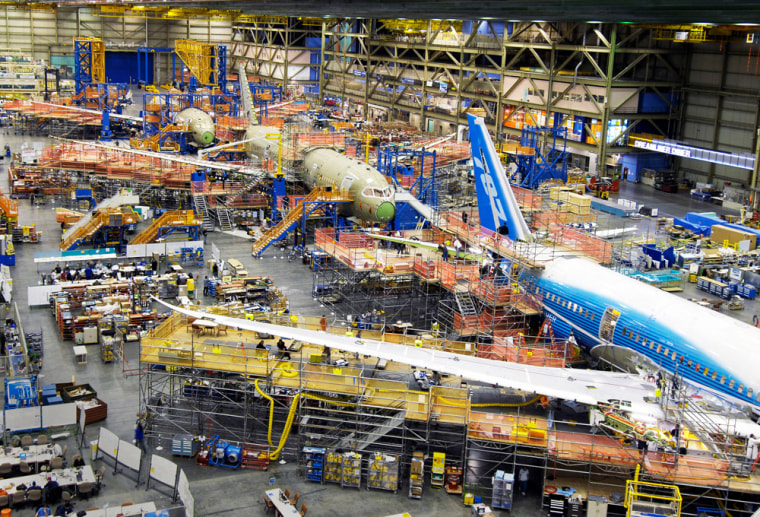Boeing took steps to restore its damaged credibility this week by declaring its 787 Dreamliner is on track to meet revised delivery targets, but the aerospace giant has a long way to go to prove the jet will meet lofty expectations.
The airplane is still six months late. Boeing’s weak supply chain is still struggling to recover. And nobody except Boeing’s top brass seems to be buying into the company’s confidence that it will meet its aggressive schedule of delivering 109 airplanes by the end of 2009.
“It’s a Herculean goal,’’ says aerospace analyst Richard Aboulafia with the Teal Group, echoing comments that analysts have been making for weeks.
In a conference call with analysts and reporters Tuesday, Boeing officials reaffirmed that they expect to meet newly revised production and delivery milestones including to “power on” the first plane in January, to fly it around the end of the first quarter of 2008, and to begin deliveries in late November or December.
“We are still ironing out significant supply-chain wrinkles,’’ said Scott Carson, head of Boeing’s Seattle-based commercial airplane manufacturing division. “Clearly risks remain. but it is a plan we believe we can achieve.”
Boeing earlier this year delayed the first flight by three months and the first delivery by six months, largely due to parts shortages and kinks in its outsourced and overburdened supply chain. But the Chicago-based manufacturer has barely cut its production schedule, which previously called for 112 planes to be delivered by the end of 2009.
Even if all the stars are aligned, analysts didn’t hear anything from Boeing officials during Tuesday’s update to assuage their doubts with regard to the production ramp up. Boeing shares dropped about 4 percent Tuesday amid a broad market downturn.
“It sounds more like an aspiration and less likely to be concrete reality,’’ says Aboulafia. “They didn’t make any compelling arguments as to how they can do it.”
Boeing cannot afford any more mistakes on the Dreamliner program. Its airline customers are anxiously awaiting their airplanes and have put Boeing on notice that if delays continue, the company could face millions of dollars in penalty payments. Boeing has already said it expects a $2.5 billion hit in 2008 to cover customer late fees and increased costs to keep its suppliers on track.
While airline customers are nervous, the orders keep coming in. Boeing has 762 orders from 52 carriers for the plane. Its extensive use of plastic composite materials, as opposed to aluminum and other metal alloys, is expected to make the Dreamliner 20 percent lighter and more fuel-efficient than comparable jets. Boeing says it has sold out delivery slots until almost 2014.
The Dreamliner’s first flight was supposed to have already happened, and test flights should have been well under way by now. Boeing must now meet its key milestones — namely “power on” and successful flight — _ before its credibility can be fully restored, says analyst Scott Hamilton. “Only then will the aerospace community be able to sit back and let out its breath.”
The biggest question remains: Will Boeing’s supply chain be able to support a ramped-up production schedule? “They are not out of the woods by a long shot,’’ Hamilton says.
Analysts remain cautiously optimistic, however, that Boeing will meet its new first flight target and its first delivery to Japan's All Nippon Airlines next year.
Boeing announced its revised delivery schedule in October and later replaced the executive in charge of the 787 program with Pat Shanahan, who previously turned around a troubled missile defense program.
After two months of assessing the 787 program, which included several late-night meetings with managers, trips to suppliers abroad and after-hours sessions in Boeing’s 787 flight simulator, Shanahan expressed confidence in the program. He acknowledged, however, that the airplane is still a “bit” overweight and that “clearly, we have a lot of work to do.”
Boeing is suffering the consequences after underestimating how hard it would be to have partners across the globe design and build major sections of the all-composite airplane.
Instead of designing and building the airplanes itself, as Boeing has done for 91 years, the company’s 787 plan calls for partners to ship mostly completed fuselage sections and other major structures already stuffed with wiring and other systems to Boeing facilities in Washington state. Boeing would then essentially snap together the airplane in as little as three days.
It is a revolutionary business model that Boeing officials still believe will rewrite the way commercial airplanes are built in the future. “This is truly a breakthrough in our industry,’’ Carson told reporters and analysts on the conference call.
The problem — compounded by parts shortages — was Boeing’s lack of vigilance in understanding its suppliers, their capabilities and challenges. Boeing was overly confident that its suppliers could meet their deadlines and work through any road blocks that arose.
“They trusted and didn’t verify,’’ Aboulafia says.
As a result, Boeing’s suppliers have been shipping the airplane sections to Boeing without the wiring and other crucial systems, requiring major rework on the factory floor.
“We warned Boeing for years that if they continued with their outsourcing they eventually would lose control of their product and become a hostage to their suppliers,’’ says Tom Wroblewski, president of Boeing’s largest union, Machinists District 751. “If our members had done the work in the first place, Boeing wouldn’t be in this mess.”
Analyst Aboulafia says Boeing is relearning a timeless lesson: “It’s better to pleasantly surprise than disappoint.”
